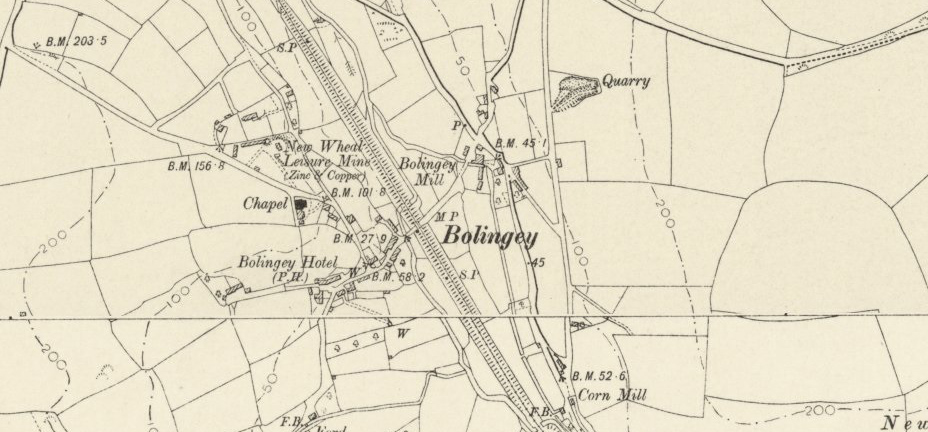
Bolingey is a village on the north coast of Cornwall half-a-mile south of the small seaside resort of Perranporth and in the civil parish of Perranzabuloe. This profile of Bolingey Wesleyan Chapel has been compiled by Karin Easton of Perranzabuloe Old Cornwall Society.
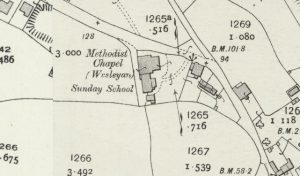
THE BUILDING
Early C19 a small chapel was built about 300 yards NW of the present building.
Late 1820s a new and larger chapel was needed for the growing congregation.
1831 June 19th the foundation stone was laid and the sermon was preached by the Rev. Boot. It was built on what was then known as Underthuel Common in a prominent position that is still a significant landmark. The congregation was drawn from a wide area – Perran (as the small hamlet was then known) Bolenna, Nampara, Reen, Rose, Goonhavern and Perranwell. The windows were of plain glass and a harmonium accompanied the singing. The pews were the box-type with doors closing at the end.
Prior to the introduction of electricity, there were oil lamps held up by hooks in “roses” in the ceiling.
Late 1860s oblong-shaped chapel deemed too small.
1863 services held at 10.30 and 6.30. There were two class meetings, at 9.30 and 10.15. Also two weekly prayer meetings.
1870 Monday 8th August the extension officially re-opened with new gable, seating capacity approx. 500.
1875 organ installed at a total cost of £160.
Christmas Day at 6.00 am Merritt’s carols were sung, the chapel being full.
1900 Perranporth County Primary School had a half-day holiday to mark the re-opening of the organ after renovation.
1904 new pews made by Mr. Robins in his workshop on Wheal Leisure for £460, most of this money being raised at a 2-day bazaar.
1906 oxyacetalene lamps in use
 Interior of Bolingey Chapel (Photo: courtesy Linda Miners)
Interior of Bolingey Chapel (Photo: courtesy Linda Miners)
1907 Chapel redecorated and three infants from Perranporth County Primary School left school early to be present.
 Bolingey Band of Hope Tea Treat 1913 (Photo: courtesy Linda Miners)
Bolingey Band of Hope Tea Treat 1913 (Photo: courtesy Linda Miners)
 Bolingey Band of Hope Tea Treat 1913? (Photo: courtesy Linda Miners)
Bolingey Band of Hope Tea Treat 1913? (Photo: courtesy Linda Miners)
Post 1918 electricity installed
 First World War memorial stone near chapel wall (Photo: courtesy Karin Easton)
First World War memorial stone near chapel wall (Photo: courtesy Karin Easton)
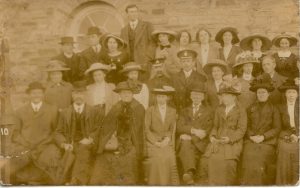 Group outside Bolingey Chapel (Photo: courtesy Linda Miners)
Group outside Bolingey Chapel (Photo: courtesy Linda Miners)
1960s Some of the congregation outside Bolingey Chapel
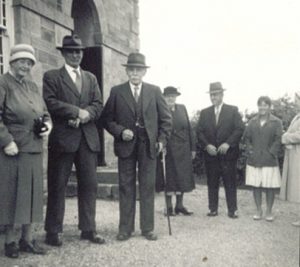
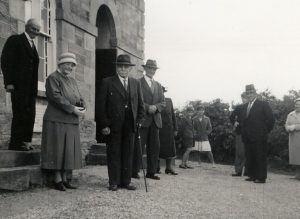 Top photo: L to R Miss Olive Cowling, Mr Alfred Hosking, Mr Ronnie Murrish, Mrs Penna, Mr Nicholas Benney, Miss Linda Rogan, Mrs Ruth Rogan (Photos: courtesy Linda Miners)
Top photo: L to R Miss Olive Cowling, Mr Alfred Hosking, Mr Ronnie Murrish, Mrs Penna, Mr Nicholas Benney, Miss Linda Rogan, Mrs Ruth Rogan (Photos: courtesy Linda Miners)
A variety of wild clematis called “Old man’s beard” was collected to wind round the Chapel pillars and lots of apples were displayed along the Gallery for Harvest Festival. There was always a really good display of fruit and vegetables at the front of the Chapel as well as some sheaves of corn.
1965 Chapel redecorated for £250.
1967 Used only in the summer months as the central heating was out of action with services held only at 11 am in the School Hall.
1978 July 6th Closure
1979 April 26th Planning permission granted for Bolingey Chapel to be converted into flats.
SUNDAY SCHOOL
1888?
It was a large room with a stage and a small side room, furnished with long forms and a piano. Access to the Chapel was through the vestry.
It was used for weekly Sunday School at 2pm.
Also held there were Faith Teas for Perran Feast and Harvest Festivals.
Choirs were fed in there after concerts held in the Chapel.
Goonhavern Banjo Band performed on the stage in the Sunday School Room.
1950s Sunday School Superintendent was Mr Uglow.
1950/60s? Youth Club
Perranzabuloe Model Engineering Club met there.
SIGNIFICANT EVENTS
C19 Bolingey Chapel played an important part in the life of the parish, as it was the main chapel in Perranzabuloe and was the centre for social events in the area.
1870 Monday 8th August Chapel re-opened for “Divine Worship” with two special preachers, one from London and one from Truro. Followed by Dinner in the Wesleyan School Room at 1 o’clock and Tea at half past four.
1870 Friday August 12th An evening lecture on “Village Life in India, Illustrated by Diagrams”
1870 Sundays August 14th, 21st and 28th As part of the re-opening of the Chapel, three Sunday services with specially invited preachers, from London, the Chairman of the District and from Hayle
Perran Feast an event in the words of Captain William Roberts “was only equalled by that of Christmas Day” … “people of all denominations used to gather in the one great meeting-place, the Bolingey Methodist Church”. Although St Piran’s date of birth was believed to be in March, in the parish of Perranzabuloe the religious anniversary of St. Piran was observed on the last Sunday in October. The following day, Feast Monday, was a day for relaxation with a fair being held in front of the present day Bolingey Inn. Afterwards the company split – some to Bolingey Chapel for tea and a “do”, others to the two ale houses called the Bolingey Inn and the Bounders Arms.
1901 Perranporth Choral Society was founded and performed Handel’s Messiah to a capacity audience. There was also a Bolingey Chapel Choir which had a good reputation.
1906 A full house to hear G. A. Morgan Esq., the Liberal Member of Parliament, preach.
1912 Thursday April 11th Perranporth & District Choral Society performed Handel’s Messiah with a band and chorus of 65 performers for the admission price of 6d. The doors opened at 6.45, the concert commenced at 7.15 and carriages were ready at 9.45.
 Programme from the collection at Perranzabuloe Museum (Photo: courtesy Karin Easton)
Programme from the collection at Perranzabuloe Museum (Photo: courtesy Karin Easton)
Chapel Concerts: Choirs and Music information from accounts books shows that from 1904 to 1927 there were regular concerts by visiting choirs. Although they continued after that date, there seemed to be a sharp decline latterly after 1927 in favour of Garden Parties which seemed more profitable. Income from concerts needed to cover the choirs’ omnibus transport, fees and refreshments before any profits were shown.
Chapel Teas “We sat on Sunday School forms which were long, very basic benches, at trestle tables stretching the whole width of the Sunday School room. Though the benches were basic, and I suppose the trestle tables were too, the tables were laid with white tablecloths and, of course in those days, there was only proper china and cutlery; with flowers and food it always looked wonderful.
Water for the tea was heated in an electric boiler that was designed for washing clothes but was kept by the Chapel for boiling water for tea, and then after for washing up. In my early childhood the Chapel only had rainwater which was used for flushing the toilet and hand washing. Water for tea was collected from the standpipe at the end of Hendrawna Lane [across the road] and brought up in a large earthenware jug/pitcher.
Of course, the most important part of this was the Faith Tea. What a treat! Contributions were always people’s specialities, or so it seemed to me. The cakes and buns were a treat. My mother made very good splits and I particularly remember Maud Tremewan’s saffron buns. I remember that we always had to start with bread and butter or a split and butter. Jam was allowed with a second piece of bread or split.
Miss Olive Cowling was in charge of tea making. She had a very good system to produce lots of cups of tea quickly with an ordinary domestic-sized teapot. She made the tea in the pot really, really strong, then poured a little into each cup, then topped them up water. This was before teabags. I think that in the evenings there was a concert.” Chris Easton, President Perranzabuloe Old Cornwall Society
NOTABLE PEOPLE
Mrs. W. H. Tremewan played the organ for 60 years. On a Sunday her family walked nearly 2 miles each way, from Sand Cot on Budnic Hill, three times a day.
Mrs. Annie Miners – followed Mrs Tremewan who had taught her. She played for many years, presumably until Mrs Coward took over in 1930.
Mrs. Arthur Coward [nee Enid Kessell, married women were always known by their husband’s name at that time, unless widowed] retired in 1965 after playing the organ for about 30 years.
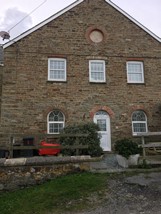 Photographed 4th October 2020 (Photo: courtesy Karin Easton)
Photographed 4th October 2020 (Photo: courtesy Karin Easton)
1978 Announcement of closure of Bolingey Chapel
1981 Planning permission granted for the Chapel and Sunday School Room to be converted into residential flats.
References
Reminiscences of Perranporth from the year 1833 by Capt. William Roberts, reprinted by Perranzabuloe OCS.
Michael Fairhead’s notes produced for a talk for a Federation of Old Cornwall Societies festival held at Bolingey Chapel in 1967.
Perranzabuloe Museum Collections, website: perranzabuloemuseum.co.uk
Perranzabuloe Old Cornwall Society members – Memories of Chris Easton, Linda Miners and David Easton who all worshipped at Bolingey Chapel.
Further memories can be found in Cornish Youth: Memories of a Perran boy (1895-1910) by Tom Tremewan

The 1875 organ was built by Brewer & Co of Truro.